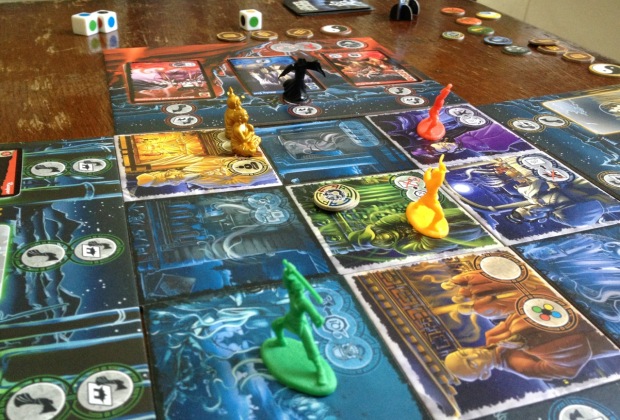Ghost Stories is a cooperative board game that sees you and up to three friends attempting to save a village from the reincarnation of the evil Wu-Feng and his army of the undead.
Set-up requires each player to take a board and a corresponding Taoist figurine and lay out nine village tiles in a random square, with the boards around the outside. The basic premise is that ghosts appear on each player’s board and thus have some effect on the game, while you must run around defending the village and exorcising ghosts.
On easy, the “Ghost Deck” has 55 cards, along with one of the 10 Wu-Feng incarnation cards placed 10 from the bottom in it. In the Yin phase of the player’s turn, and in a few other instances, the active player takes the top ghost card and brings it into play. If possible it should be placed on the corresponding colour board (a yellow ghost on the yellow board for example), with each board having three spaces that line up with the village tiles.

Then you enact the ghost’s actions, shown at the bottom of the card. There are three kinds, leftmost are for the turn the ghost comes into play, middle is for every subsequent turn and the right is a curse or reward to be taken once the ghost has been exorcized. These could be a roll of the curse die, or haunting a space in the village. It’s pretty random in nature; the ghosts encroach steadily but there’s no doubt that the pressure ramps up as more and more pile onto the board.
The second half of your turn is the Yang phase. Here you control your Taoist, moving them around the board and either interacting with a villager or exorcising ghosts. To do this, you must be next to the location of a ghost on a player’s board, and then roll the three Tao dice. Ghosts have a resistance, corresponding to their colour. To defeat a ghost whose resistance is “2, Blue” you’ll need 2 blues from the dice roll, with each side of the dice marking one of a colour. There is also a white spot on each dice, which can stand in for a colour of your choosing, and tokens can be picked up to complement your roll, again each corresponding to a colour.
While players start off with one token the colour of their board and one black one, more can be collected through rewards or from the village tiles. For example, the herbalist’s shop allows you to roll two Tao dice and take tokens of the corresponding colour. Other examples are villagers who allow you to un-haunt another tile – haunting prevents you from using that tile’s villager or costing you the game if too many are lost – or banish a ghost at the cost of a health point.

Each player has four of these, although losing them is not the end of the game, and another player can reincarnate you on the cemetery tile. There are different tokens, variations for an easier or harder game, as well as a single player variant that’s quite fun. Ghost Stories at its best is fantastic fun: fending off the ghost assault is essentially the board game equivalent of horde mode.
I will say that it’s hard to get into. The amount of tokens and dice is a little overwhelming at first and you will lose your first game. The instructions don’t help, as they needlessly confusing at times and simple things are given daft names. Qi points may be more in keeping with the setting, but health points are health points.
VERDICT: Should you buy Ghost Stories then? I’d say yes, but don’t be under any illusions: it’s a hard game to get the hang of, but once you’re up and running and it all just clicks, Ghost Stories is really good fun.
Dan Naylor
Hi all, I'm Dan 'Nailz' Naylor, News Editor for the site (and I've just realised there's a pleasing alliteration to that). Almost all the news posts you see on the site are either by me or written because I say so, and we try to make them a little more interesting than a regurgitated press release so I hope you think we're succeeding.
Normally I'll be sinking my time into the latest RPG, but I'll play almost anything, with racing games a particular favourite. Owner of a Wii U, I have no regrets purchasing the console, though Smash Bros. hasn't left the disc tray since Christmas.
You can find me on Twitter and PSN as MacShanks, and feel free to hit me up if you have any questions, queries or feedback!





